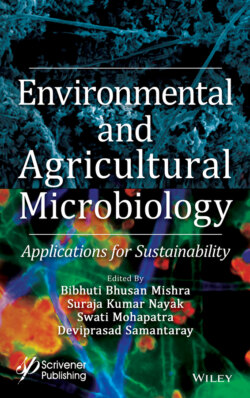Читать книгу Environmental and Agricultural Microbiology - Группа авторов - Страница 62
3.5.1 Biosorption
ОглавлениеThe capability of biological materials to accumulate or bind heavy metals present in the wastewater of polluted water bodies through metabolically facilitated or physico-chemical pathways is called biosorption. All microorganisms (algae, bacteria, fungi, and yeast) are proved to be potential metal biosorbents. This method of treatment is having some advantages such as cost effectiveness, highly efficient and effective, reduction chemical and biological slurry, no extra nutrient necessity, revival of biosorbent, and probability of metal reclamation [65]. The sorption of metal can take place by microorganisms following two different processes: active process and passive process [66].
Active process: This process is metabolism dependent and also called as bioaccumulation process. In this process, transport of metal through the membrane of cell with a subsequent accumulation of intracellular metal facilitated through metabolism of cell. Only viable cells can perform bioaccumulation, which are also often linked with a mechanism of resistance initiated through microorganism in the existence of a toxic metal [66].
Passive process: This process is a metabolism-independent process, otherwise known as biosorption. This is a physic-chemical process, normally includes four mechanism (adsorption, ion-exchange, complexation, and precipitation) and this mechanism helps to transport metal inside the cell [66].
Adsorption: The adsorption occurs with the help of van der Waals’ force [52, 64]. The selective materials for adsorption of Cr(VI) and Ni(II) are “crushed initiated carbon > bagasse > fly ash” and “crushed initiated carbon >fly ash >bagasse”, respectively. The lower pH of 6.0 is suitable for removal of Cr(VI) and pH 8.0 is appropriate condition for removal of Ni(II) ions. The limitation of adsorption is that the ability is very low and their use for industrial runoffs treatment cannot be defensible [22].
Ion-exchange: In biosorption process, the ion-exchange method was first introduced by Volesky and Holan (1995) and is backing through numerous current studies [66]. In passive absorption, the ion exchange method has essential role. In this mechanism, the biomass is displayed toward metal because the first metal aliquots are continuously discharged in to the solution while the second metal is combined, and a portion of second metal is combined to the bio-sorbent. This assay is suitable for Cu2+ and Pb2+ removal [67].
Complexion: In this method, the complex formation on the cell surface after communication between metals and functional groups of microorganisms occurs for metal removal from the solution. The magnesium, copper, calcium, mercury, zinc, and cadmium accumulation via Pseudomonas syringae takes place and is removed by simply complexion mechanism. The organic acid may produce by microorganisms may chelate toxic metals, resulting in makeup of metallo-organic molecules [65].
Figure 3.2 Mechanism of biosorption.
Precipitation: The precipitation may be dependent or autonomous to metabolism process. The metal elimination from solution is frequently linked by the functional defense system of microorganisms. The microorganisms behave in the occurrence of noxious metal generating compounds such as metallothionein and phytochelatins and induce the precipitation method. This method is not dependent upon the cellular metabolism; rather, it may be a chemical reaction significantly occurs among the metal and the cell surface, with an indigenous aggregation of ions of metal and their subsequent precipitation. The mechanism of biosorption is described overhead may occur concurrently (Figure 3.2) [65, 66].
